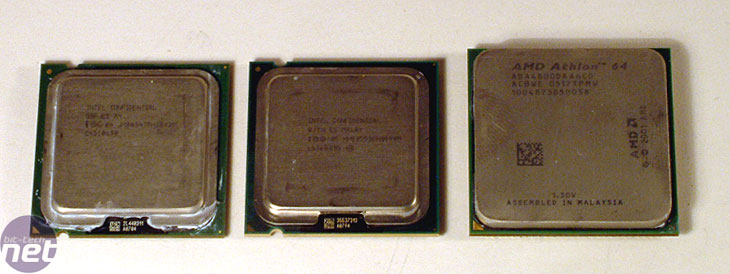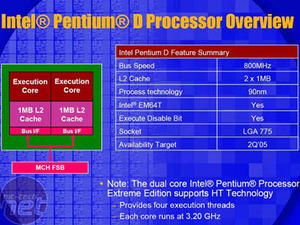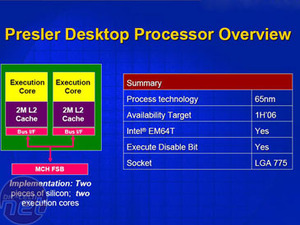

How does the latest addition to the Extreme Edition line rack up against Intel's Pentium 4's and AMD's single and dual core processors? Read on to find out...
Intel Pentium Extreme Edition 955:
The Pentium Extreme Edition 955 processor is Intel's first 65 nanometre processor, and is based on the Presler core. It's clocked at 3.46GHz (13.0 x 267MHz) with a 1066MHz front side bus. Unlike the Smithfield core, which was used in the 90 nanometre Pentium D's and Pentium Extreme Edition 840, the Presler core has two separate dies. This eliminates some of the limitations of the Smithfield core, but not all of them, unfortunately.It's good, because it should help Intel to get superb yields on its 65 nanometre dual core CPUs. This is because the Presler core (or cores, depending on which way you look at it) is actually two Cedar Mill cores located on the same package. Having two separate cores means that Intel can pick and choose good Cedar Mill cores and pair them together to make a Presler core from anywhere on the wafer. This is instead of having to worry about defects on one of the two cores on the Smithfield die rendering the other useless.
However, it's bad in the sense that the Presler's two cores still communicate with eachother via the front side bus, as opposed to the on-die communication system that AMD uses in the Athlon 64 X2. Despite each core having its own bus interface, this method of communication between the two cores has its limitations.
Having said that, the move to a 1066MHz front side bus means that there is an improvement over the Smithfield-based Pentium Ds. When the two cores communicate with each other via the shared bus, the Presler core has an increased peak throughput of 8.5GB/s, compared to the somewhat limited peak throughput of 6.4GB/s on the Smithfield core. We're still not quite at the theoretical 10.7GB/s of memory bandwidth available to the 975X chipset, but we're getting closer. We'll discuss the new chipset a little more over the page.

Pentium 4 Extreme Edition 3.73GHz, Pentium Extreme Edition 955, Athlon 64 X2 4800+. Spot the difference between the two Intel chips if you can - we can't...
Much like the Pentium Extreme Edition 840, the Extreme Edition 955 supports Intel's HyperThreading technology on both cores, meaning that it's possible to execute four threads simulaneously. While some characteristics (such as caches, execution units and buses) of each independant die are shared, HyperThreading technology enables each logical processor to use its own set of general purpose registers and control registers to provide an even smoother feel to the whole multi-tasking environment.

Pentium 4 Extreme Edition 3.73GHz, Pentium Extreme Edition 955
Software, such as VMware, has been able to emulate this process for a while now, but the inclusion of the technology on die will take performance on a step further. In short, the technology essentially allows the CPU to act as if it was several CPUs working in parallel and subsequently run several operating systems and/or applications to run simultaneously on the same machine. You might confuse this with HyperThreading technology, but it's actually a little different.
HyperThreading only allows you to execute multiple threads in a single operating system by simulating two CPUs - these two logical CPUs cannot be used separately. Obviously, the Pentium Extreme Edition 955 is a dual core processor, so there are four logical threads as opposed to two - the theory is the same, though.

MSI MPG Velox 100R Chassis Review
October 14 2021 | 15:04








Want to comment? Please log in.